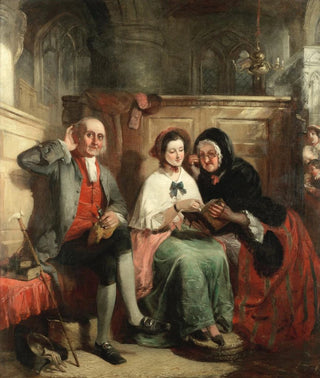Art print | After the sermon - William Powell Frith


View from behind

Frame (optional)
William Powell Frith's "After the Sermon" is a true window into Victorian life, capturing a moment of reflection and emotion in a pastoral setting. This painting, created in 1851, transports us to a scene where characters, dressed in period costumes, discuss the teachings of a sermon. The artist succeeds in immortalizing the essence of an era while inviting us to contemplate the social and spiritual dynamics that prevailed at the time. The depiction of light, facial expressions, and human interactions in this work creates an atmosphere that is both intimate and universal, allowing viewers to reflect on themes of faith, community, and contemplation.
Style and uniqueness of the work
Frith's style is distinguished by its meticulous realism and ability to capture everyday details. In "After the Sermon," every element, from the setting to the expressions of the characters, is carefully crafted to create a rich visual narrative. The composition is skillfully orchestrated, with a play of light that highlights the faces and gestures of the protagonists. The colors, both vivid and nuanced, add emotional depth to the scene, emphasizing the contrasts between the interior of the church and the outside world. This painting does not merely depict a moment; it evokes an atmosphere, a mood that resonates with the spiritual and social concerns of its time. Frith thus manages to transcend simple realism by offering a reflection on human nature.
The artist and his influence
William Powell Frith, born in 1819, is often regarded as one of the most influential painters of the 19th century in England. His work is characterized by a deep commitment to social and moral themes, which allows him to stand out in the artistic landscape of his era. Frith captured the nuances of daily life while addressing sometimes controversial subjects. His work has inspired many contemporary and later artists, who saw in him a model of visual storytelling. By focusing on aspects of Victorian life, he also contributed to a better understanding of the society of his time, making him an essential witness of the era.

Matte finish

View from behind

Frame (optional)
William Powell Frith's "After the Sermon" is a true window into Victorian life, capturing a moment of reflection and emotion in a pastoral setting. This painting, created in 1851, transports us to a scene where characters, dressed in period costumes, discuss the teachings of a sermon. The artist succeeds in immortalizing the essence of an era while inviting us to contemplate the social and spiritual dynamics that prevailed at the time. The depiction of light, facial expressions, and human interactions in this work creates an atmosphere that is both intimate and universal, allowing viewers to reflect on themes of faith, community, and contemplation.
Style and uniqueness of the work
Frith's style is distinguished by its meticulous realism and ability to capture everyday details. In "After the Sermon," every element, from the setting to the expressions of the characters, is carefully crafted to create a rich visual narrative. The composition is skillfully orchestrated, with a play of light that highlights the faces and gestures of the protagonists. The colors, both vivid and nuanced, add emotional depth to the scene, emphasizing the contrasts between the interior of the church and the outside world. This painting does not merely depict a moment; it evokes an atmosphere, a mood that resonates with the spiritual and social concerns of its time. Frith thus manages to transcend simple realism by offering a reflection on human nature.
The artist and his influence
William Powell Frith, born in 1819, is often regarded as one of the most influential painters of the 19th century in England. His work is characterized by a deep commitment to social and moral themes, which allows him to stand out in the artistic landscape of his era. Frith captured the nuances of daily life while addressing sometimes controversial subjects. His work has inspired many contemporary and later artists, who saw in him a model of visual storytelling. By focusing on aspects of Victorian life, he also contributed to a better understanding of the society of his time, making him an essential witness of the era.






